Recording, Analyzing, and Using Human Resources Information (3RAI)
VerifiedAdded on 2023/06/04
|12
|2752
|491
Report
AI Summary
This report provides a comprehensive analysis of recording, analyzing, and using HR information within an organization. It covers the reasons for collecting HR data, the types of data collected, methods of storing records (including paper files and technical management), and the legal requirements related to data collection and storage. The report also discusses qualitative and quantitative research methodologies for analyzing HR data, including inductive and deductive approaches, research design, and data collection steps. Furthermore, it highlights the importance of data in supporting HR practices, such as meeting legal needs, managing sickness and absence, and making informed decisions to enhance employee performance and organizational productivity. The document is available on Desklib, a platform offering a wealth of study resources for students.
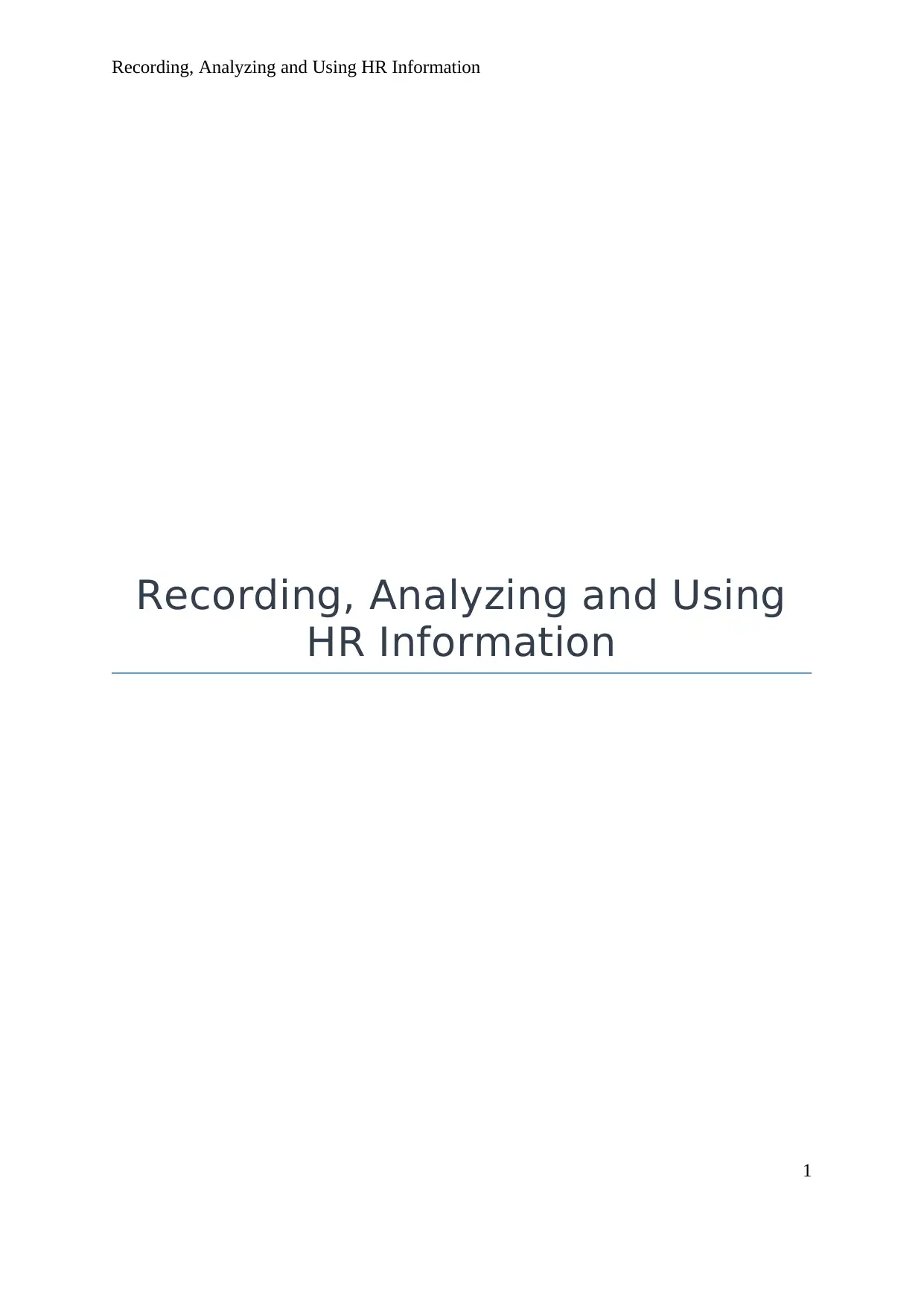
Recording, Analyzing and Using HR Information
Recording, Analyzing and Using
HR Information
1
Recording, Analyzing and Using
HR Information
1
Paraphrase This Document
Need a fresh take? Get an instant paraphrase of this document with our AI Paraphraser
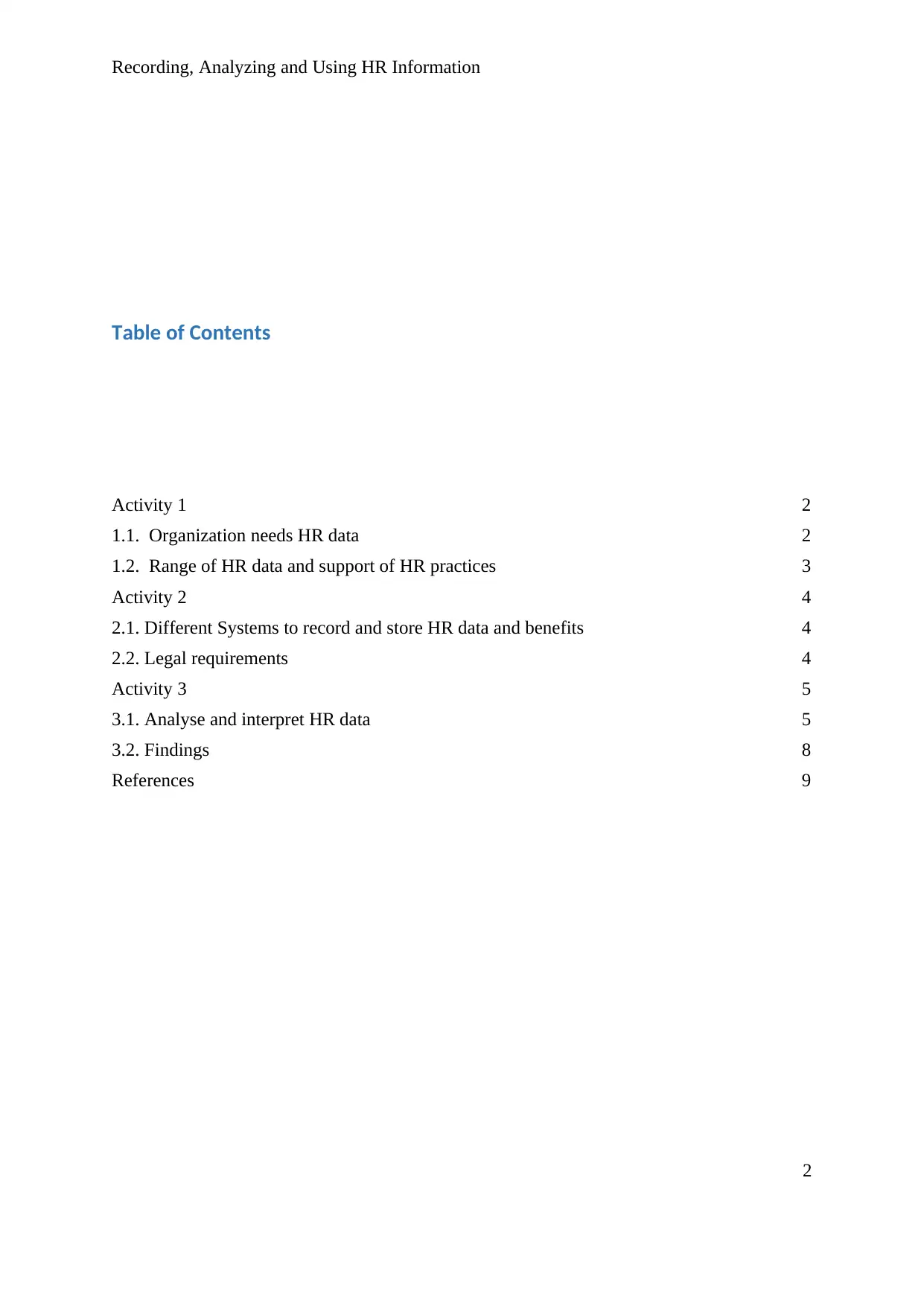
Recording, Analyzing and Using HR Information
Table of Contents
Activity 1 2
1.1. Organization needs HR data 2
1.2. Range of HR data and support of HR practices 3
Activity 2 4
2.1. Different Systems to record and store HR data and benefits 4
2.2. Legal requirements 4
Activity 3 5
3.1. Analyse and interpret HR data 5
3.2. Findings 8
References 9
2
Table of Contents
Activity 1 2
1.1. Organization needs HR data 2
1.2. Range of HR data and support of HR practices 3
Activity 2 4
2.1. Different Systems to record and store HR data and benefits 4
2.2. Legal requirements 4
Activity 3 5
3.1. Analyse and interpret HR data 5
3.2. Findings 8
References 9
2
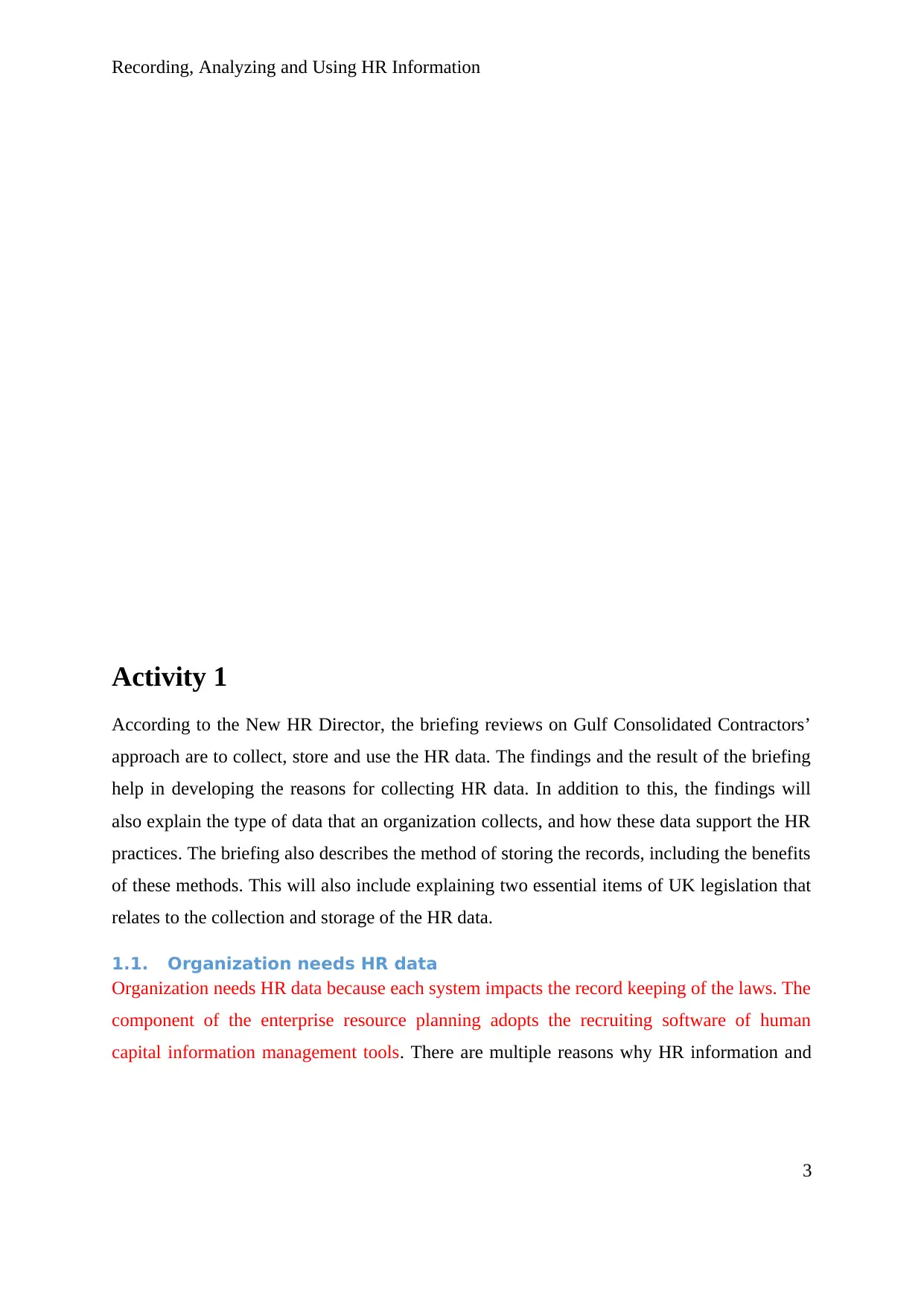
Recording, Analyzing and Using HR Information
Activity 1
According to the New HR Director, the briefing reviews on Gulf Consolidated Contractors’
approach are to collect, store and use the HR data. The findings and the result of the briefing
help in developing the reasons for collecting HR data. In addition to this, the findings will
also explain the type of data that an organization collects, and how these data support the HR
practices. The briefing also describes the method of storing the records, including the benefits
of these methods. This will also include explaining two essential items of UK legislation that
relates to the collection and storage of the HR data.
1.1. Organization needs HR data
Organization needs HR data because each system impacts the record keeping of the laws. The
component of the enterprise resource planning adopts the recruiting software of human
capital information management tools. There are multiple reasons why HR information and
3
Activity 1
According to the New HR Director, the briefing reviews on Gulf Consolidated Contractors’
approach are to collect, store and use the HR data. The findings and the result of the briefing
help in developing the reasons for collecting HR data. In addition to this, the findings will
also explain the type of data that an organization collects, and how these data support the HR
practices. The briefing also describes the method of storing the records, including the benefits
of these methods. This will also include explaining two essential items of UK legislation that
relates to the collection and storage of the HR data.
1.1. Organization needs HR data
Organization needs HR data because each system impacts the record keeping of the laws. The
component of the enterprise resource planning adopts the recruiting software of human
capital information management tools. There are multiple reasons why HR information and
3
⊘ This is a preview!⊘
Do you want full access?
Subscribe today to unlock all pages.

Trusted by 1+ million students worldwide
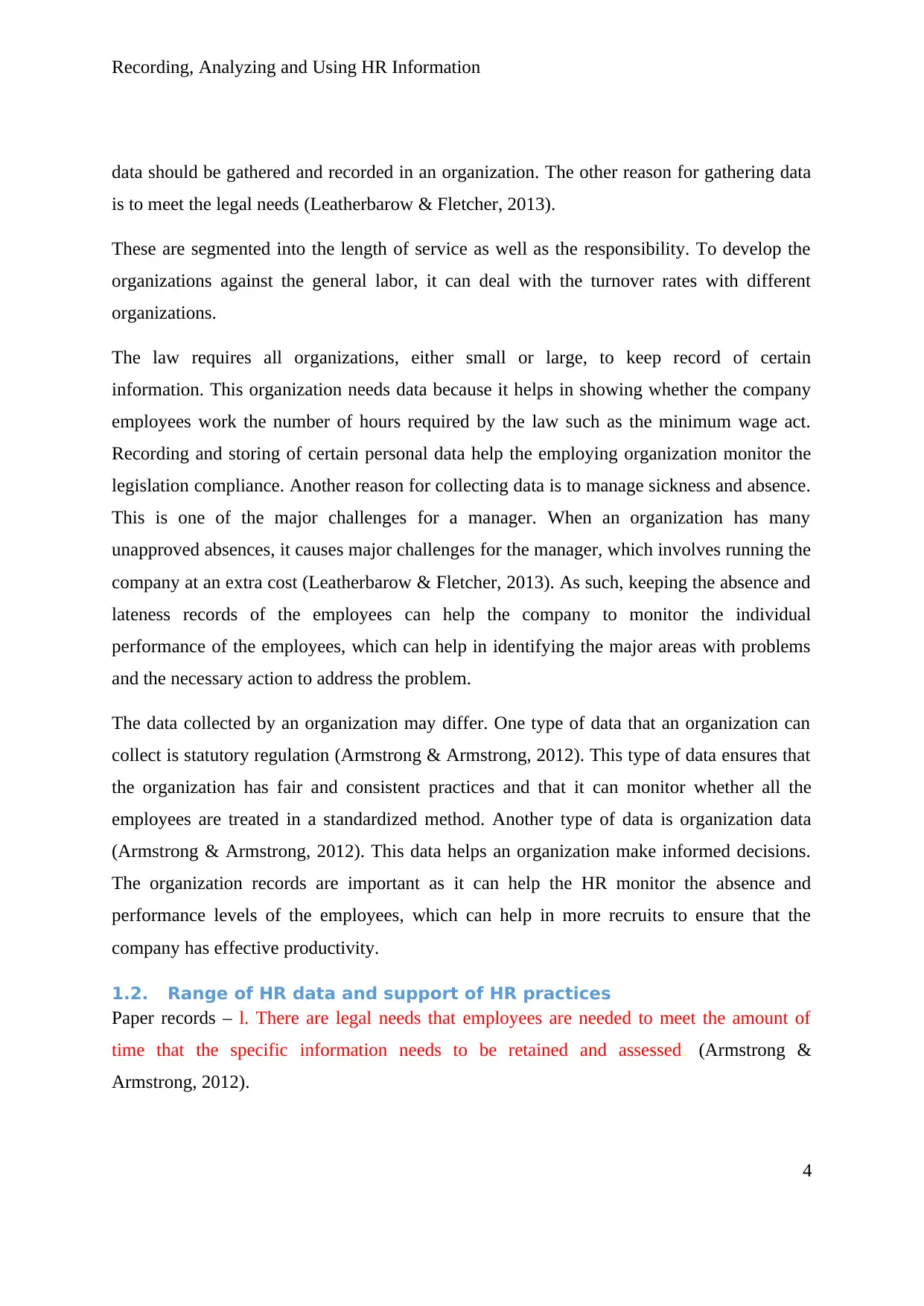
Recording, Analyzing and Using HR Information
data should be gathered and recorded in an organization. The other reason for gathering data
is to meet the legal needs (Leatherbarow & Fletcher, 2013).
These are segmented into the length of service as well as the responsibility. To develop the
organizations against the general labor, it can deal with the turnover rates with different
organizations.
The law requires all organizations, either small or large, to keep record of certain
information. This organization needs data because it helps in showing whether the company
employees work the number of hours required by the law such as the minimum wage act.
Recording and storing of certain personal data help the employing organization monitor the
legislation compliance. Another reason for collecting data is to manage sickness and absence.
This is one of the major challenges for a manager. When an organization has many
unapproved absences, it causes major challenges for the manager, which involves running the
company at an extra cost (Leatherbarow & Fletcher, 2013). As such, keeping the absence and
lateness records of the employees can help the company to monitor the individual
performance of the employees, which can help in identifying the major areas with problems
and the necessary action to address the problem.
The data collected by an organization may differ. One type of data that an organization can
collect is statutory regulation (Armstrong & Armstrong, 2012). This type of data ensures that
the organization has fair and consistent practices and that it can monitor whether all the
employees are treated in a standardized method. Another type of data is organization data
(Armstrong & Armstrong, 2012). This data helps an organization make informed decisions.
The organization records are important as it can help the HR monitor the absence and
performance levels of the employees, which can help in more recruits to ensure that the
company has effective productivity.
1.2. Range of HR data and support of HR practices
Paper records – l. There are legal needs that employees are needed to meet the amount of
time that the specific information needs to be retained and assessed. (Armstrong &
Armstrong, 2012).
4
data should be gathered and recorded in an organization. The other reason for gathering data
is to meet the legal needs (Leatherbarow & Fletcher, 2013).
These are segmented into the length of service as well as the responsibility. To develop the
organizations against the general labor, it can deal with the turnover rates with different
organizations.
The law requires all organizations, either small or large, to keep record of certain
information. This organization needs data because it helps in showing whether the company
employees work the number of hours required by the law such as the minimum wage act.
Recording and storing of certain personal data help the employing organization monitor the
legislation compliance. Another reason for collecting data is to manage sickness and absence.
This is one of the major challenges for a manager. When an organization has many
unapproved absences, it causes major challenges for the manager, which involves running the
company at an extra cost (Leatherbarow & Fletcher, 2013). As such, keeping the absence and
lateness records of the employees can help the company to monitor the individual
performance of the employees, which can help in identifying the major areas with problems
and the necessary action to address the problem.
The data collected by an organization may differ. One type of data that an organization can
collect is statutory regulation (Armstrong & Armstrong, 2012). This type of data ensures that
the organization has fair and consistent practices and that it can monitor whether all the
employees are treated in a standardized method. Another type of data is organization data
(Armstrong & Armstrong, 2012). This data helps an organization make informed decisions.
The organization records are important as it can help the HR monitor the absence and
performance levels of the employees, which can help in more recruits to ensure that the
company has effective productivity.
1.2. Range of HR data and support of HR practices
Paper records – l. There are legal needs that employees are needed to meet the amount of
time that the specific information needs to be retained and assessed. (Armstrong &
Armstrong, 2012).
4
Paraphrase This Document
Need a fresh take? Get an instant paraphrase of this document with our AI Paraphraser
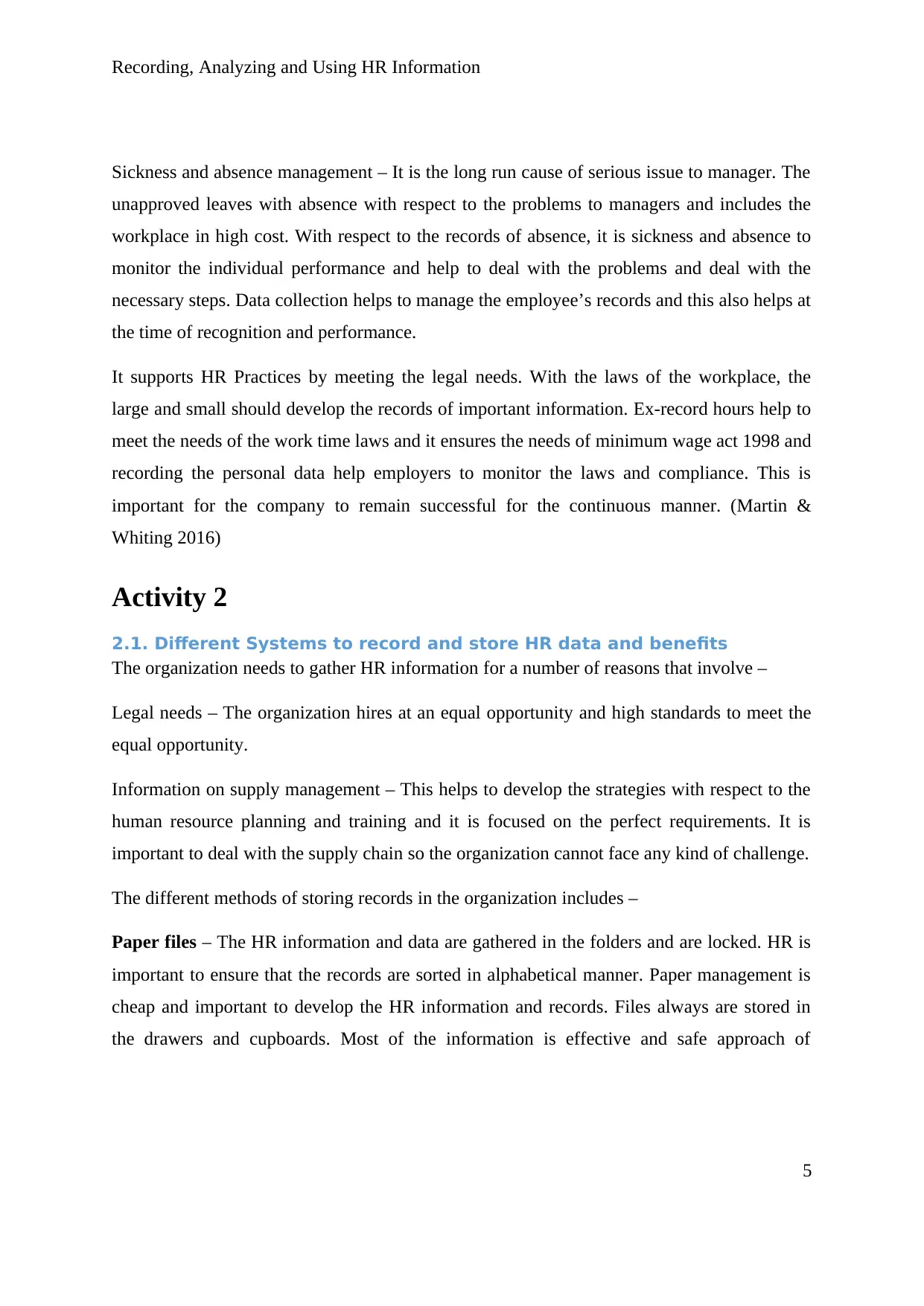
Recording, Analyzing and Using HR Information
Sickness and absence management – It is the long run cause of serious issue to manager. The
unapproved leaves with absence with respect to the problems to managers and includes the
workplace in high cost. With respect to the records of absence, it is sickness and absence to
monitor the individual performance and help to deal with the problems and deal with the
necessary steps. Data collection helps to manage the employee’s records and this also helps at
the time of recognition and performance.
It supports HR Practices by meeting the legal needs. With the laws of the workplace, the
large and small should develop the records of important information. Ex-record hours help to
meet the needs of the work time laws and it ensures the needs of minimum wage act 1998 and
recording the personal data help employers to monitor the laws and compliance. This is
important for the company to remain successful for the continuous manner. (Martin &
Whiting 2016)
Activity 2
2.1. Different Systems to record and store HR data and benefits
The organization needs to gather HR information for a number of reasons that involve –
Legal needs – The organization hires at an equal opportunity and high standards to meet the
equal opportunity.
Information on supply management – This helps to develop the strategies with respect to the
human resource planning and training and it is focused on the perfect requirements. It is
important to deal with the supply chain so the organization cannot face any kind of challenge.
The different methods of storing records in the organization includes –
Paper files – The HR information and data are gathered in the folders and are locked. HR is
important to ensure that the records are sorted in alphabetical manner. Paper management is
cheap and important to develop the HR information and records. Files always are stored in
the drawers and cupboards. Most of the information is effective and safe approach of
5
Sickness and absence management – It is the long run cause of serious issue to manager. The
unapproved leaves with absence with respect to the problems to managers and includes the
workplace in high cost. With respect to the records of absence, it is sickness and absence to
monitor the individual performance and help to deal with the problems and deal with the
necessary steps. Data collection helps to manage the employee’s records and this also helps at
the time of recognition and performance.
It supports HR Practices by meeting the legal needs. With the laws of the workplace, the
large and small should develop the records of important information. Ex-record hours help to
meet the needs of the work time laws and it ensures the needs of minimum wage act 1998 and
recording the personal data help employers to monitor the laws and compliance. This is
important for the company to remain successful for the continuous manner. (Martin &
Whiting 2016)
Activity 2
2.1. Different Systems to record and store HR data and benefits
The organization needs to gather HR information for a number of reasons that involve –
Legal needs – The organization hires at an equal opportunity and high standards to meet the
equal opportunity.
Information on supply management – This helps to develop the strategies with respect to the
human resource planning and training and it is focused on the perfect requirements. It is
important to deal with the supply chain so the organization cannot face any kind of challenge.
The different methods of storing records in the organization includes –
Paper files – The HR information and data are gathered in the folders and are locked. HR is
important to ensure that the records are sorted in alphabetical manner. Paper management is
cheap and important to develop the HR information and records. Files always are stored in
the drawers and cupboards. Most of the information is effective and safe approach of
5
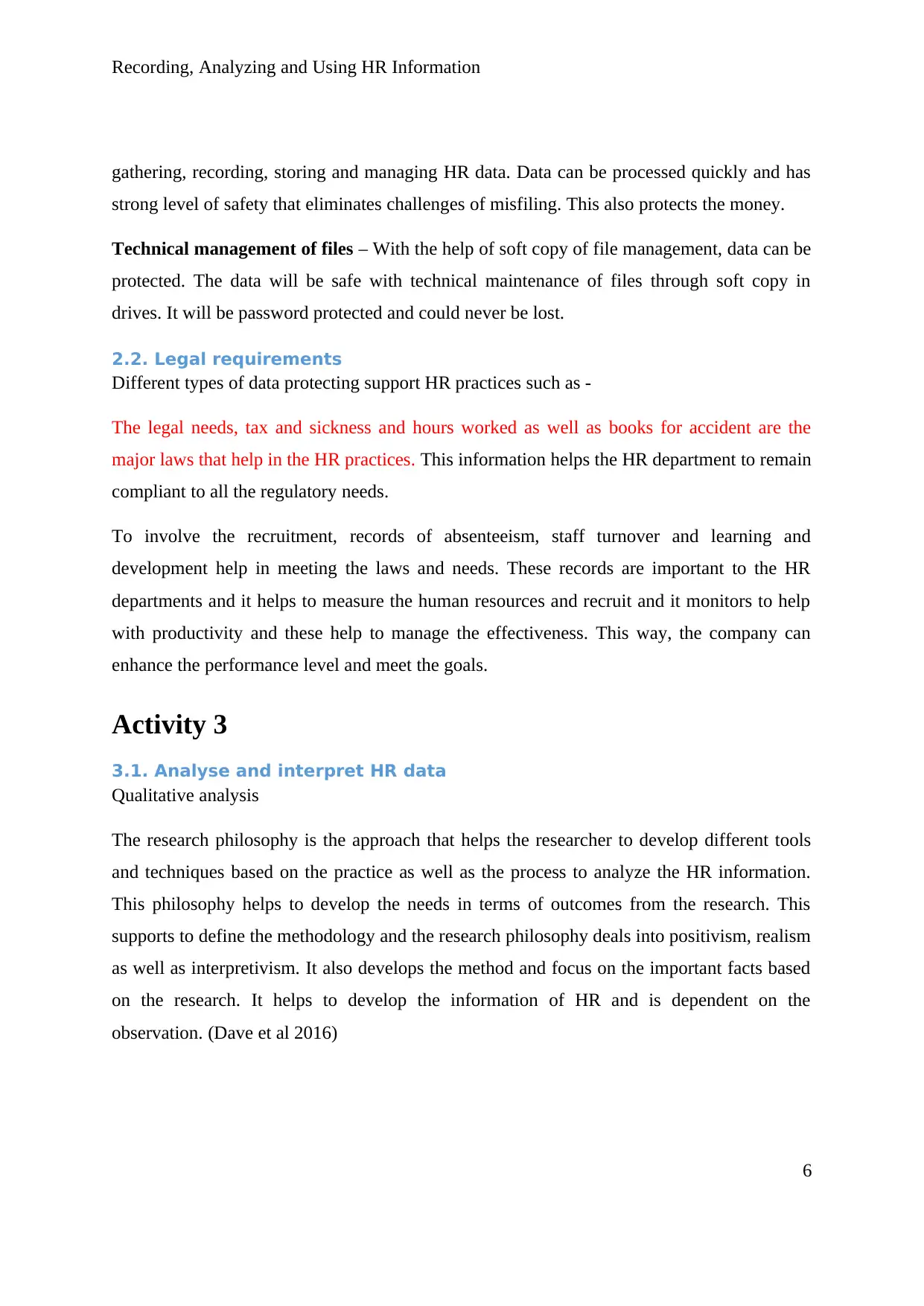
Recording, Analyzing and Using HR Information
gathering, recording, storing and managing HR data. Data can be processed quickly and has
strong level of safety that eliminates challenges of misfiling. This also protects the money.
Technical management of files – With the help of soft copy of file management, data can be
protected. The data will be safe with technical maintenance of files through soft copy in
drives. It will be password protected and could never be lost.
2.2. Legal requirements
Different types of data protecting support HR practices such as -
The legal needs, tax and sickness and hours worked as well as books for accident are the
major laws that help in the HR practices. This information helps the HR department to remain
compliant to all the regulatory needs.
To involve the recruitment, records of absenteeism, staff turnover and learning and
development help in meeting the laws and needs. These records are important to the HR
departments and it helps to measure the human resources and recruit and it monitors to help
with productivity and these help to manage the effectiveness. This way, the company can
enhance the performance level and meet the goals.
Activity 3
3.1. Analyse and interpret HR data
Qualitative analysis
The research philosophy is the approach that helps the researcher to develop different tools
and techniques based on the practice as well as the process to analyze the HR information.
This philosophy helps to develop the needs in terms of outcomes from the research. This
supports to define the methodology and the research philosophy deals into positivism, realism
as well as interpretivism. It also develops the method and focus on the important facts based
on the research. It helps to develop the information of HR and is dependent on the
observation. (Dave et al 2016)
6
gathering, recording, storing and managing HR data. Data can be processed quickly and has
strong level of safety that eliminates challenges of misfiling. This also protects the money.
Technical management of files – With the help of soft copy of file management, data can be
protected. The data will be safe with technical maintenance of files through soft copy in
drives. It will be password protected and could never be lost.
2.2. Legal requirements
Different types of data protecting support HR practices such as -
The legal needs, tax and sickness and hours worked as well as books for accident are the
major laws that help in the HR practices. This information helps the HR department to remain
compliant to all the regulatory needs.
To involve the recruitment, records of absenteeism, staff turnover and learning and
development help in meeting the laws and needs. These records are important to the HR
departments and it helps to measure the human resources and recruit and it monitors to help
with productivity and these help to manage the effectiveness. This way, the company can
enhance the performance level and meet the goals.
Activity 3
3.1. Analyse and interpret HR data
Qualitative analysis
The research philosophy is the approach that helps the researcher to develop different tools
and techniques based on the practice as well as the process to analyze the HR information.
This philosophy helps to develop the needs in terms of outcomes from the research. This
supports to define the methodology and the research philosophy deals into positivism, realism
as well as interpretivism. It also develops the method and focus on the important facts based
on the research. It helps to develop the information of HR and is dependent on the
observation. (Dave et al 2016)
6
⊘ This is a preview!⊘
Do you want full access?
Subscribe today to unlock all pages.

Trusted by 1+ million students worldwide
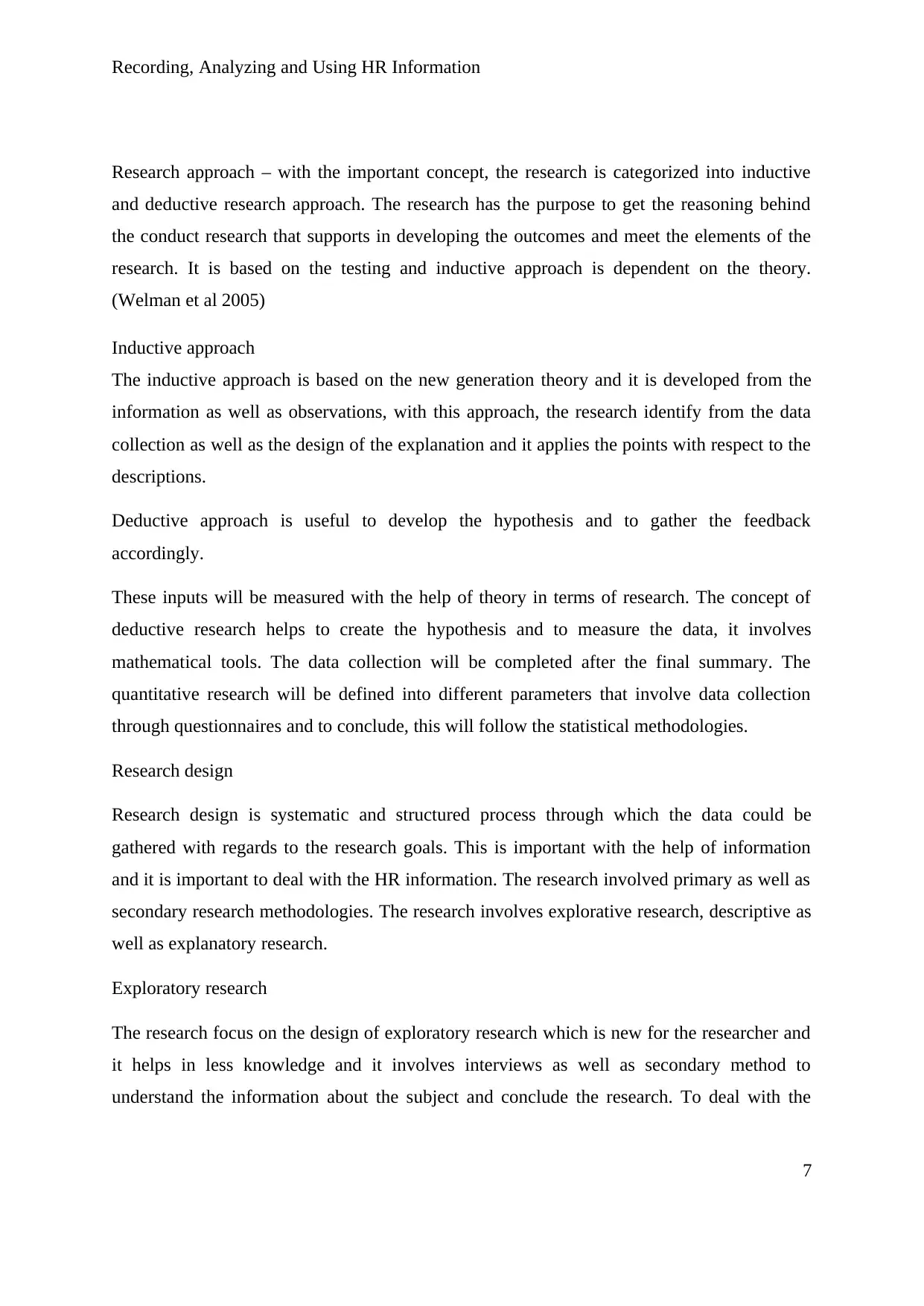
Recording, Analyzing and Using HR Information
Research approach – with the important concept, the research is categorized into inductive
and deductive research approach. The research has the purpose to get the reasoning behind
the conduct research that supports in developing the outcomes and meet the elements of the
research. It is based on the testing and inductive approach is dependent on the theory.
(Welman et al 2005)
Inductive approach
The inductive approach is based on the new generation theory and it is developed from the
information as well as observations, with this approach, the research identify from the data
collection as well as the design of the explanation and it applies the points with respect to the
descriptions.
Deductive approach is useful to develop the hypothesis and to gather the feedback
accordingly.
These inputs will be measured with the help of theory in terms of research. The concept of
deductive research helps to create the hypothesis and to measure the data, it involves
mathematical tools. The data collection will be completed after the final summary. The
quantitative research will be defined into different parameters that involve data collection
through questionnaires and to conclude, this will follow the statistical methodologies.
Research design
Research design is systematic and structured process through which the data could be
gathered with regards to the research goals. This is important with the help of information
and it is important to deal with the HR information. The research involved primary as well as
secondary research methodologies. The research involves explorative research, descriptive as
well as explanatory research.
Exploratory research
The research focus on the design of exploratory research which is new for the researcher and
it helps in less knowledge and it involves interviews as well as secondary method to
understand the information about the subject and conclude the research. To deal with the
7
Research approach – with the important concept, the research is categorized into inductive
and deductive research approach. The research has the purpose to get the reasoning behind
the conduct research that supports in developing the outcomes and meet the elements of the
research. It is based on the testing and inductive approach is dependent on the theory.
(Welman et al 2005)
Inductive approach
The inductive approach is based on the new generation theory and it is developed from the
information as well as observations, with this approach, the research identify from the data
collection as well as the design of the explanation and it applies the points with respect to the
descriptions.
Deductive approach is useful to develop the hypothesis and to gather the feedback
accordingly.
These inputs will be measured with the help of theory in terms of research. The concept of
deductive research helps to create the hypothesis and to measure the data, it involves
mathematical tools. The data collection will be completed after the final summary. The
quantitative research will be defined into different parameters that involve data collection
through questionnaires and to conclude, this will follow the statistical methodologies.
Research design
Research design is systematic and structured process through which the data could be
gathered with regards to the research goals. This is important with the help of information
and it is important to deal with the HR information. The research involved primary as well as
secondary research methodologies. The research involves explorative research, descriptive as
well as explanatory research.
Exploratory research
The research focus on the design of exploratory research which is new for the researcher and
it helps in less knowledge and it involves interviews as well as secondary method to
understand the information about the subject and conclude the research. To deal with the
7
Paraphrase This Document
Need a fresh take? Get an instant paraphrase of this document with our AI Paraphraser
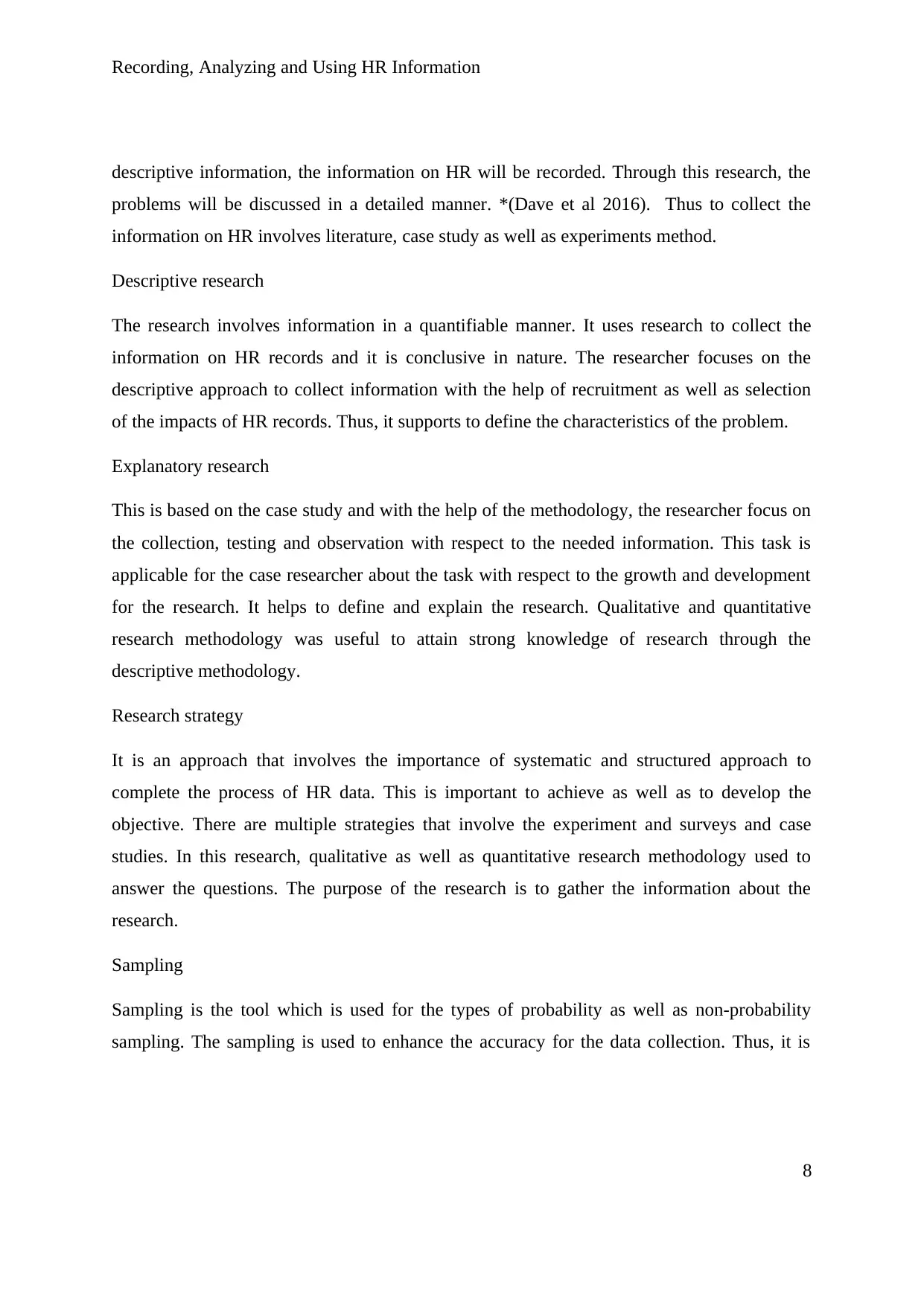
Recording, Analyzing and Using HR Information
descriptive information, the information on HR will be recorded. Through this research, the
problems will be discussed in a detailed manner. *(Dave et al 2016). Thus to collect the
information on HR involves literature, case study as well as experiments method.
Descriptive research
The research involves information in a quantifiable manner. It uses research to collect the
information on HR records and it is conclusive in nature. The researcher focuses on the
descriptive approach to collect information with the help of recruitment as well as selection
of the impacts of HR records. Thus, it supports to define the characteristics of the problem.
Explanatory research
This is based on the case study and with the help of the methodology, the researcher focus on
the collection, testing and observation with respect to the needed information. This task is
applicable for the case researcher about the task with respect to the growth and development
for the research. It helps to define and explain the research. Qualitative and quantitative
research methodology was useful to attain strong knowledge of research through the
descriptive methodology.
Research strategy
It is an approach that involves the importance of systematic and structured approach to
complete the process of HR data. This is important to achieve as well as to develop the
objective. There are multiple strategies that involve the experiment and surveys and case
studies. In this research, qualitative as well as quantitative research methodology used to
answer the questions. The purpose of the research is to gather the information about the
research.
Sampling
Sampling is the tool which is used for the types of probability as well as non-probability
sampling. The sampling is used to enhance the accuracy for the data collection. Thus, it is
8
descriptive information, the information on HR will be recorded. Through this research, the
problems will be discussed in a detailed manner. *(Dave et al 2016). Thus to collect the
information on HR involves literature, case study as well as experiments method.
Descriptive research
The research involves information in a quantifiable manner. It uses research to collect the
information on HR records and it is conclusive in nature. The researcher focuses on the
descriptive approach to collect information with the help of recruitment as well as selection
of the impacts of HR records. Thus, it supports to define the characteristics of the problem.
Explanatory research
This is based on the case study and with the help of the methodology, the researcher focus on
the collection, testing and observation with respect to the needed information. This task is
applicable for the case researcher about the task with respect to the growth and development
for the research. It helps to define and explain the research. Qualitative and quantitative
research methodology was useful to attain strong knowledge of research through the
descriptive methodology.
Research strategy
It is an approach that involves the importance of systematic and structured approach to
complete the process of HR data. This is important to achieve as well as to develop the
objective. There are multiple strategies that involve the experiment and surveys and case
studies. In this research, qualitative as well as quantitative research methodology used to
answer the questions. The purpose of the research is to gather the information about the
research.
Sampling
Sampling is the tool which is used for the types of probability as well as non-probability
sampling. The sampling is used to enhance the accuracy for the data collection. Thus, it is
8
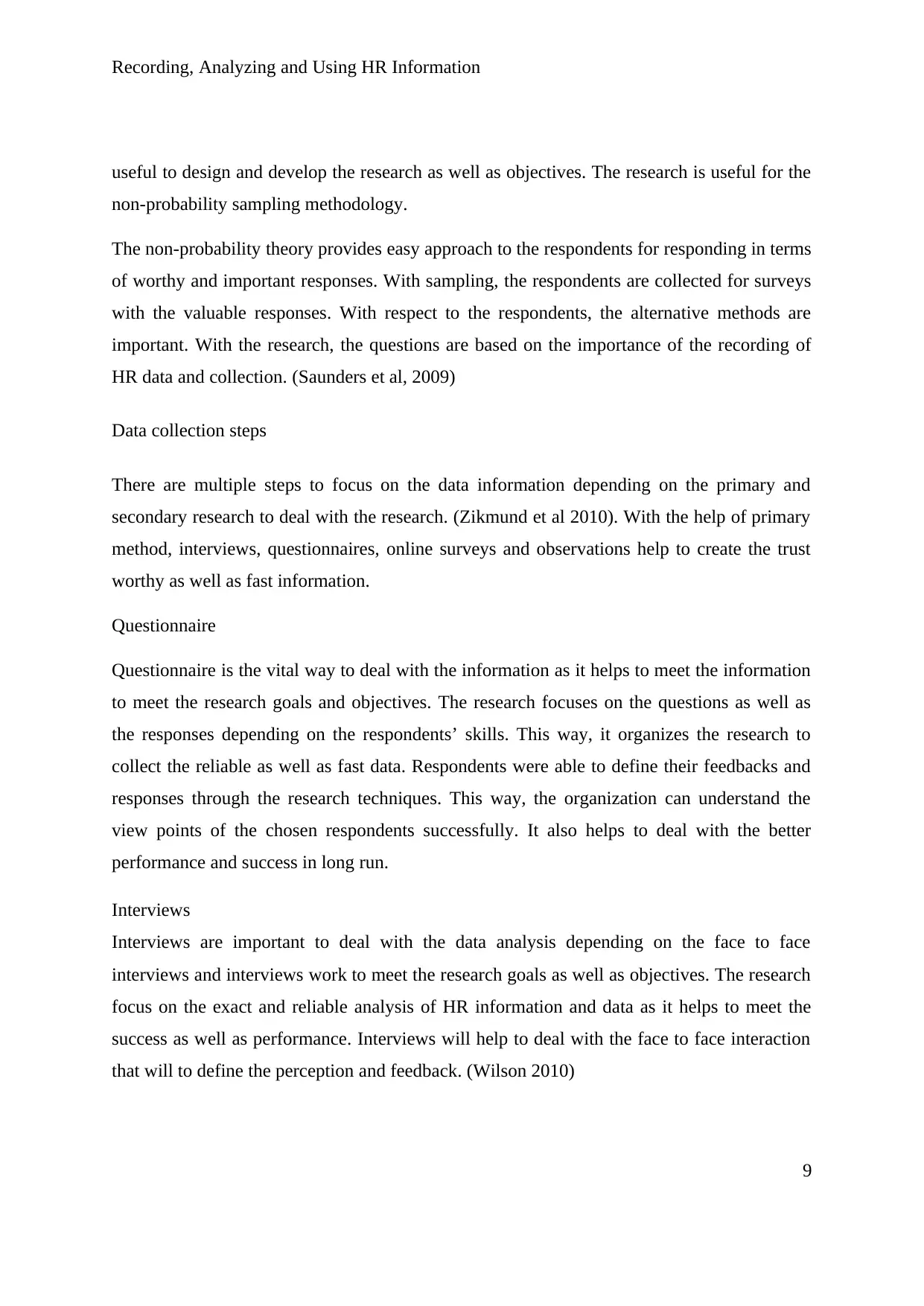
Recording, Analyzing and Using HR Information
useful to design and develop the research as well as objectives. The research is useful for the
non-probability sampling methodology.
The non-probability theory provides easy approach to the respondents for responding in terms
of worthy and important responses. With sampling, the respondents are collected for surveys
with the valuable responses. With respect to the respondents, the alternative methods are
important. With the research, the questions are based on the importance of the recording of
HR data and collection. (Saunders et al, 2009)
Data collection steps
There are multiple steps to focus on the data information depending on the primary and
secondary research to deal with the research. (Zikmund et al 2010). With the help of primary
method, interviews, questionnaires, online surveys and observations help to create the trust
worthy as well as fast information.
Questionnaire
Questionnaire is the vital way to deal with the information as it helps to meet the information
to meet the research goals and objectives. The research focuses on the questions as well as
the responses depending on the respondents’ skills. This way, it organizes the research to
collect the reliable as well as fast data. Respondents were able to define their feedbacks and
responses through the research techniques. This way, the organization can understand the
view points of the chosen respondents successfully. It also helps to deal with the better
performance and success in long run.
Interviews
Interviews are important to deal with the data analysis depending on the face to face
interviews and interviews work to meet the research goals as well as objectives. The research
focus on the exact and reliable analysis of HR information and data as it helps to meet the
success as well as performance. Interviews will help to deal with the face to face interaction
that will to define the perception and feedback. (Wilson 2010)
9
useful to design and develop the research as well as objectives. The research is useful for the
non-probability sampling methodology.
The non-probability theory provides easy approach to the respondents for responding in terms
of worthy and important responses. With sampling, the respondents are collected for surveys
with the valuable responses. With respect to the respondents, the alternative methods are
important. With the research, the questions are based on the importance of the recording of
HR data and collection. (Saunders et al, 2009)
Data collection steps
There are multiple steps to focus on the data information depending on the primary and
secondary research to deal with the research. (Zikmund et al 2010). With the help of primary
method, interviews, questionnaires, online surveys and observations help to create the trust
worthy as well as fast information.
Questionnaire
Questionnaire is the vital way to deal with the information as it helps to meet the information
to meet the research goals and objectives. The research focuses on the questions as well as
the responses depending on the respondents’ skills. This way, it organizes the research to
collect the reliable as well as fast data. Respondents were able to define their feedbacks and
responses through the research techniques. This way, the organization can understand the
view points of the chosen respondents successfully. It also helps to deal with the better
performance and success in long run.
Interviews
Interviews are important to deal with the data analysis depending on the face to face
interviews and interviews work to meet the research goals as well as objectives. The research
focus on the exact and reliable analysis of HR information and data as it helps to meet the
success as well as performance. Interviews will help to deal with the face to face interaction
that will to define the perception and feedback. (Wilson 2010)
9
⊘ This is a preview!⊘
Do you want full access?
Subscribe today to unlock all pages.

Trusted by 1+ million students worldwide

Recording, Analyzing and Using HR Information
Observation
Observation helps to create actions based on the analysis as well as actions. The HR data and
information are difficult to deal with the effectiveness of information and it is important to
record. The data collection is important to deal with the effectiveness of information and it is
important to record. The action of responses is vital and it helps to deal in a logical manner.
3.2. Findings
Data analysis is vital to deal with the policies of HR practices as well as support and it is
important to deal with the statistics. It helps to develop the importance in terms of charts,
tables and graphs for the fast development of information. The results are collected with the
help of conclusion.
10
Observation
Observation helps to create actions based on the analysis as well as actions. The HR data and
information are difficult to deal with the effectiveness of information and it is important to
record. The data collection is important to deal with the effectiveness of information and it is
important to record. The action of responses is vital and it helps to deal in a logical manner.
3.2. Findings
Data analysis is vital to deal with the policies of HR practices as well as support and it is
important to deal with the statistics. It helps to develop the importance in terms of charts,
tables and graphs for the fast development of information. The results are collected with the
help of conclusion.
10
Paraphrase This Document
Need a fresh take? Get an instant paraphrase of this document with our AI Paraphraser
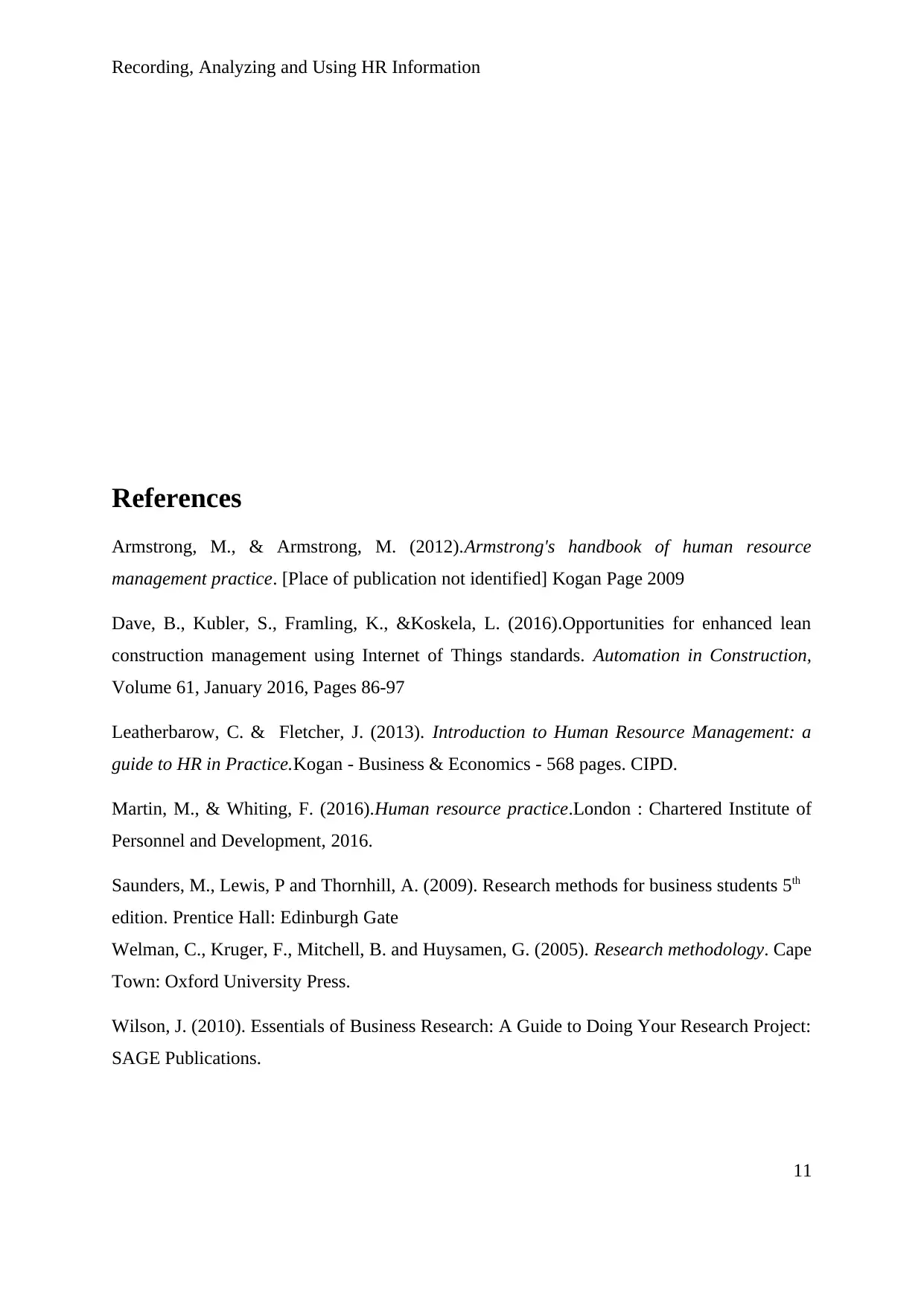
Recording, Analyzing and Using HR Information
References
Armstrong, M., & Armstrong, M. (2012).Armstrong's handbook of human resource
management practice. [Place of publication not identified] Kogan Page 2009
Dave, B., Kubler, S., Framling, K., &Koskela, L. (2016).Opportunities for enhanced lean
construction management using Internet of Things standards. Automation in Construction,
Volume 61, January 2016, Pages 86-97
Leatherbarow, C. & Fletcher, J. (2013). Introduction to Human Resource Management: a
guide to HR in Practice.Kogan - Business & Economics - 568 pages. CIPD.
Martin, M., & Whiting, F. (2016).Human resource practice.London : Chartered Institute of
Personnel and Development, 2016.
Saunders, M., Lewis, P and Thornhill, A. (2009). Research methods for business students 5th
edition. Prentice Hall: Edinburgh Gate
Welman, C., Kruger, F., Mitchell, B. and Huysamen, G. (2005). Research methodology. Cape
Town: Oxford University Press.
Wilson, J. (2010). Essentials of Business Research: A Guide to Doing Your Research Project:
SAGE Publications.
11
References
Armstrong, M., & Armstrong, M. (2012).Armstrong's handbook of human resource
management practice. [Place of publication not identified] Kogan Page 2009
Dave, B., Kubler, S., Framling, K., &Koskela, L. (2016).Opportunities for enhanced lean
construction management using Internet of Things standards. Automation in Construction,
Volume 61, January 2016, Pages 86-97
Leatherbarow, C. & Fletcher, J. (2013). Introduction to Human Resource Management: a
guide to HR in Practice.Kogan - Business & Economics - 568 pages. CIPD.
Martin, M., & Whiting, F. (2016).Human resource practice.London : Chartered Institute of
Personnel and Development, 2016.
Saunders, M., Lewis, P and Thornhill, A. (2009). Research methods for business students 5th
edition. Prentice Hall: Edinburgh Gate
Welman, C., Kruger, F., Mitchell, B. and Huysamen, G. (2005). Research methodology. Cape
Town: Oxford University Press.
Wilson, J. (2010). Essentials of Business Research: A Guide to Doing Your Research Project:
SAGE Publications.
11
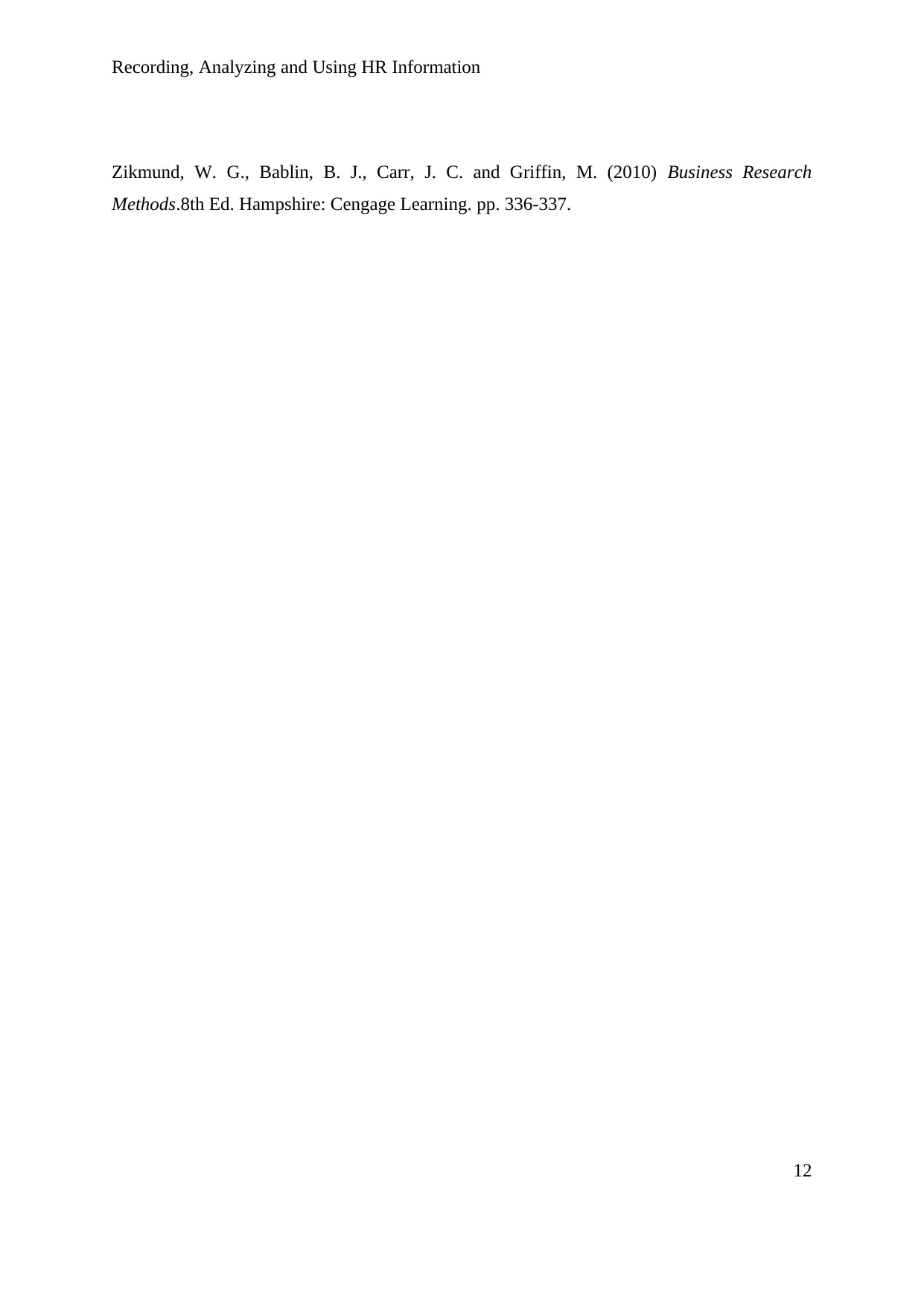
Recording, Analyzing and Using HR Information
Zikmund, W. G., Bablin, B. J., Carr, J. C. and Griffin, M. (2010) Business Research
Methods.8th Ed. Hampshire: Cengage Learning. pp. 336-337.
12
Zikmund, W. G., Bablin, B. J., Carr, J. C. and Griffin, M. (2010) Business Research
Methods.8th Ed. Hampshire: Cengage Learning. pp. 336-337.
12
⊘ This is a preview!⊘
Do you want full access?
Subscribe today to unlock all pages.

Trusted by 1+ million students worldwide
1 out of 12
Related Documents
Your All-in-One AI-Powered Toolkit for Academic Success.
+13062052269
info@desklib.com
Available 24*7 on WhatsApp / Email
![[object Object]](/_next/static/media/star-bottom.7253800d.svg)
Unlock your academic potential
Copyright © 2020–2025 A2Z Services. All Rights Reserved. Developed and managed by ZUCOL.




